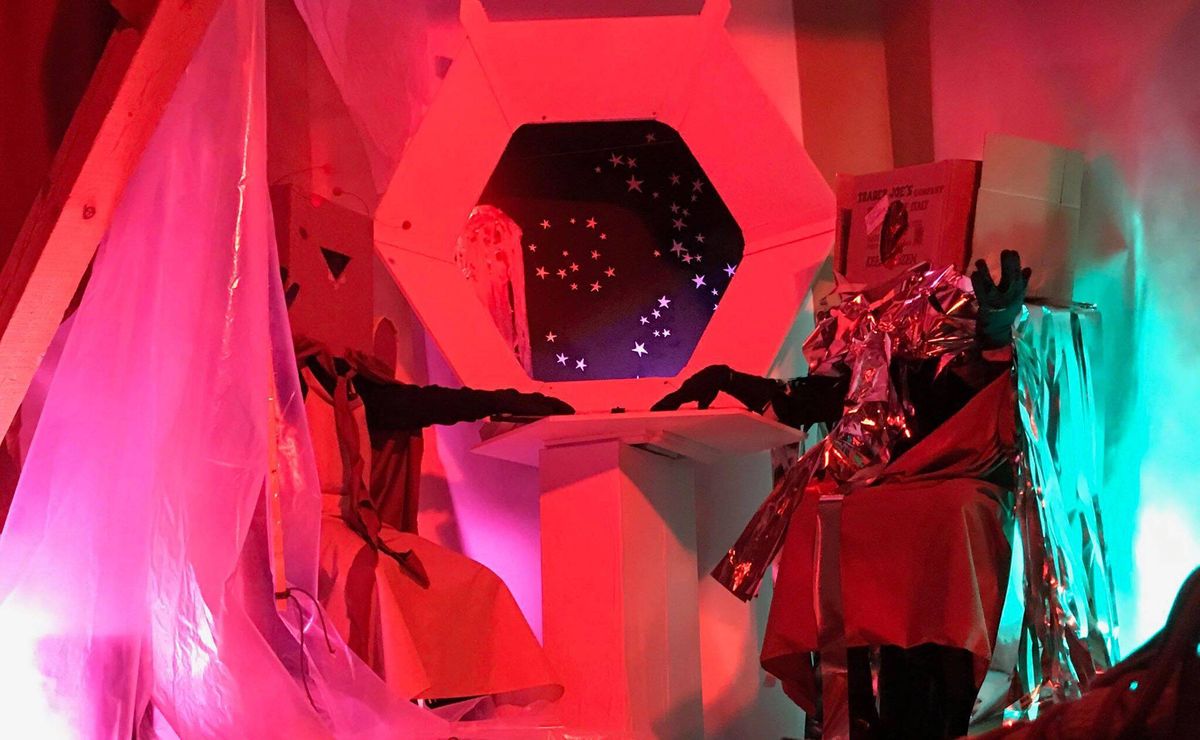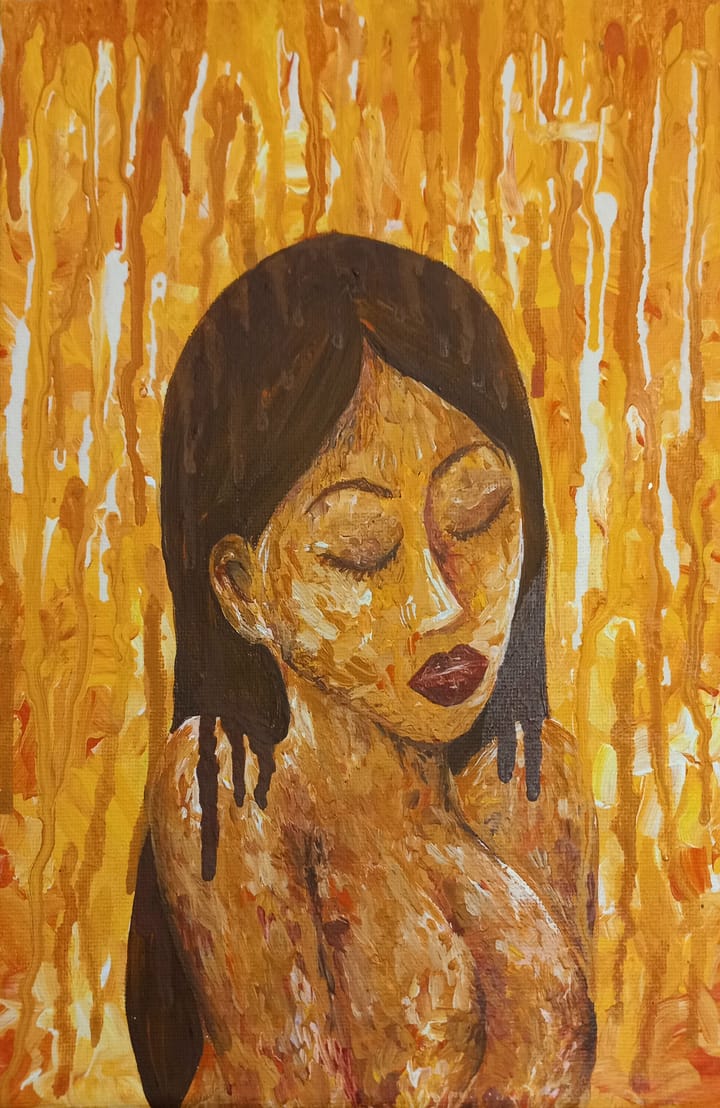A Quirky, Artistic Tribute to Community and Cardboard

What do people and boxes all have in common? According to the performance artists in Whoop Dee Doo’s interactive art installation “Have You Seen the Ghost of John?”, the answer is the right to fall in love. Although the show was held in collaboration with Macon Reed’s “On World-Making: Context, Narrative, Myth and Truth” class at Amherst, it was only through the whispers of a few keen individuals that I was able to hear about the project and secure a spot at one of the three same-day showings which were held on the third floor of Fayerweather Hall.
While these might sound like a strange assortment of individuals and items to premise an entire show around, Whoop Dee Doo makes a point of embracing the absurd. For over a decade, the travelling and performance-based project has explored what it means to make meaningful and unique community-based art. For this project, that includes enlisting local artists to create a bizarre world of bright colors, transcendental sounds and experimental theater elements.
The performance art leanings of the project prove the mission of Whoop Dee Doo unique enough; however it is the limited show runs and community-based focus that truly make the project notable. There is an element of ephemerality that characterizes Whoop Dee Doo and its works: the production is preceded by little fanfare and hardly more than a Facebook page advertising the upcoming spectacle.
This third floor corner of Fayerweather is a floor rarely seen by even the most studious of art students who may consider themselves regulars of the hall. However, on April 12, the warm attic space of the floor was packed with assorted community members from the five colleges, alongside many artists from the greater Amherst community.
A docent dressed as a cardboard box ushered small groups into a classroom that had been flipped to embody the image of a futuristic haunted attic. Towering stacks of cardboard boxes flanked the sides of a makeshift stage emblazoned with a monochromatic “Whoop Dee Doo” logo. The letters reflected onto the foggy metallic floor below it, littered loosely by packing peanuts. The space was tight, and silence washed over the seated audience in anticipation of a host. However, the only cue the show had begun was the complete cutting of the lights. With a flash, the lights returned in a burning red, as the flaps of the cardboard boxes opened in unison. From each hole, a sheet ghost popped out its head and began to sing an eerie a cappella rendition of the old children’s song “Have You Seen the Ghost of John?” for which the show was named.
At the end of the song, the flaps closed, and the lights were cut once more. The lights blinked back on in a fluttering of pink and blue which left a blurry patchwork on the reflective floor, lighting the room from above and below. A set of boxes cleared away to reveal a falling curtain and a “2001: A Space Odyssey”-inspired display constructed entirely of cardboard. Two figures draped in tin-foil clothing with cardboard boxes for heads sat in front of a picturesque window, revealing a cartoon-y universe of stars as they conversed about the potential whereabouts of the ghost of John.
The remainder of the show passed through skits like these, phasing through a series of dancers and another round of singing ghosts. The turning point of the show came after a pause of darkness when a man popped out of a cardboard coffin toting a white Fender electric guitar while sporting fuzzy black hair and round, wire-rimmed glasses.
“It’s me, the ghost of John,” he paused, as he announced himself in a feigned British accent, “Lennon.” He went on to perform a song titled “Boxy Lady” about boxes falling in love. The tune was admittedly a catchy success with the audience, even though the British accent disappeared as soon as the song began. Despite that being the climax of the show, it was the most stripped-back and traditional performance of the evening. While most performance artworks maintain an air of earnestness that is frowned upon to laugh at, in this moment the audience was clearly invited to enjoy the comedic nature of the spectacle.
“Boxy Lady” was emphasized by the penultimate skit which featured two boxes engaged in a wedding ceremony as an organ rendition of Richard Wagner’s ever-familiar “Bridal Chorus” played. A priest humorously ordained the ceremony between the two partners, asking, “Box, will you take Box to be your loyally wedded box? And Box, will you take Box to be your loyally wedded box?”
The show concluded with the return of the singing sheet ghosts who covered Kehlani’s “Honey,” the lyrics of which were cleverly reworded to be box-centric puns. Confetti fell from the ceiling, turning the room into the site of a wedding reception. The audience left the space feeling as if they had witnessed some act of love, despite the curious experimental elements and the lack of narrative that marked the short performance. While perhaps not the explicit point of the performance, in some way, the audience had witnessed an act of love. Whoop Dee Doo had met its mission of bringing together a diverse group of creators who had shared their collective passions in an art piece centered on the joy of community.
Like any good performance piece, the meaning of “Have You Seen the Ghost of John?” is highly contentious and the verdict is still out on whether the performance is a bizarre tribute to cardboard and John Lennon, the absurdities of love, both or perhaps neither. Regardless of intent, the piece was immensely enjoyed by the audience, myself included. While the performance lasted no more than 20 minutes, the work of Whoop Dee Doo has certainly left a lasting impression. As it turns out, bringing together the community to celebrate the life and love of cardboard boxes as soundtracked by the ghost of John Lennon is exactly what the Amherst community needed.





Comments ()